ARTS / CULTURE & LEISURE
Latest study links Southwest China's prehistoric populations to Tibetan and Austroasiatic origins

Photo: CCTV
Newly sequenced ancient genomes from Southwest China's Yunnan Province have provided new insights into human prehistory in East Asia. In a study published in Science on Friday, a Chinese research team led by Fu Qiaomei at the Institute of Vertebrate Paleontology and Paleoanthropology of the Chinese Academy of Sciences revealed that this region is crucial for understanding the origins of both Tibetan and Austroasiatic (ethnic groups with a shared language group in South and Southeast Asia) population groups.
The team analyzed data from 127 ancient human genome, dating from 7,100 to 1,400 years ago, and found that a 7,100-year-old individual from Yunnan was as genetically distinct from most present-day East Asians as a 40,000-year-old individual from the area of present-day Beijing, suggesting a previously unobserved Asian ancestry, termed Xingyi ancestry. Collectively, these ancestries highlight the profound genetic divergence among human populations in East Asia, according to a response from the institute to the Global Times on Friday.
Although the individual differed genetically from modern East Asians, the researchers noted that the individual's ancestry shared similarities with populations indigenous to the Qinghai-Xizang Plateau. This aligns with previous observations that these plateau populations possess distinct genetic characteristics from other present-day human groups.
This individual's genome fills a significant gap in understanding Tibetan prehistory. The study revealed that an early Asian population that separated at least 40,000 years ago persisted in Southwestern China until the Holocene and interacted with humans migrating westward from northern East Asia to originate Tibetan populations.
This deeply diverged Xingyi ancestry was also identified in an 11,000-year-old Longlin individual from South China's Guangxi Zhuang Autonumous Region, however it gradually disappeared in later Guangxi populations.
Moreover, the researchers conducted a genome-wide analysis of DNA from individuals living in central Yunnan between 5,100 and 1,400 years ago. Their study revealed a shared ancestry that was closely related — but genetically distinct — from East Asian ancestries observed in northern and southern China. According to the researchers, the Yunnan individuals genetically diverged from northern and southern East Asian groups at least 19,000 years ago.
Interestingly, the Yunnan samples also share a close genetic relationship with Austroasiatic speakers, who are widespread today across Southeast Asia, as well as parts of South Asia and southern China.
Some scientists have hypothesized that the spread of Austroasiatic speakers was linked to the expansion of agriculture in this region. However, the presence of these Austroasiatic-related populations in central Yunnan predates the advent of farming.
This study offers insights into the origins of Austroasiatic populations. It presents the oldest evidence of ancestry associated with Austroasiatic speakers, with a continuous record from 5,100 to 1,400 years before present. Looking to central Yunnan and the nearby Red River Valley could be crucial for uncovering Austroasiatic prehistory.
The study also sheds light on the history of populations in western and southeastern Yunnan. Specifically, genetic analyses indicate that populations with northern East Asian ancestry influenced groups in western Yunnan, while distinct northern East Asian ancestries impacted populations in southeastern Yunnan.
According to the researchers, Southwest China is a critical region for prehistoric human migration and interaction. By accessing the genetic history preserved in these ancient genomes from Yunnan, the researchers have uncovered deep genetic diversity that helps explain the rich ethnic and linguistic diversity in Yunnan today. This research has also transformed understanding of ancient human dynamics over a much wider geographic area, from the Qinghai-Xizang Plateau to Southeast Asia.
The study's comprehensive analysis of ancient DNA from Yunnan populations dating from 7,100 to 1,400 years ago provides fresh insight into long-standing debates over the origins and expansion of East Asian populations.


